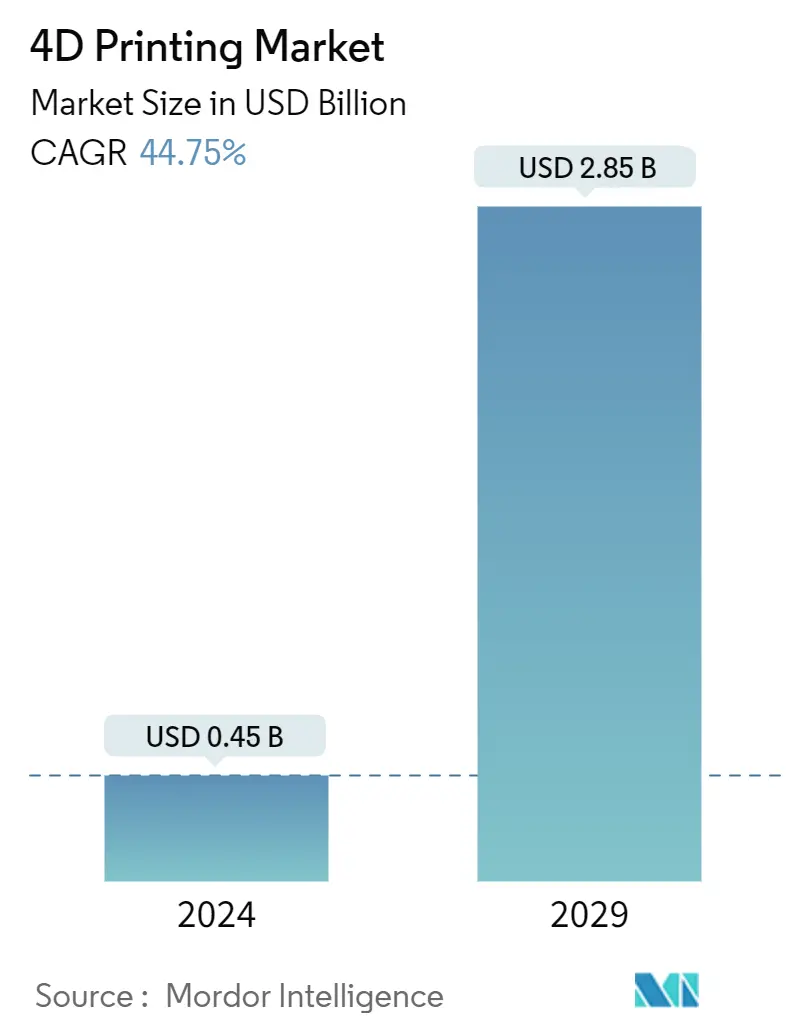Market Size of 4D Printing Industry

| Study Period | 2019 - 2029 |
| Market Size (2024) | USD 0.45 Billion |
| Market Size (2029) | USD 2.85 Billion |
| CAGR (2024 - 2029) | 44.75 % |
| Fastest Growing Market | Asia Pacific |
| Largest Market | North America |
| Market Concentration | Low |
Major Players
*Disclaimer: Major Players sorted in no particular order |
4D Printing Market Analysis
The 4D Printing Market size is estimated at USD 0.45 billion in 2024, and is expected to reach USD 2.85 billion by 2029, growing at a CAGR of 44.75% during the forecast period (2024-2029).
The advancement in bio-fabrication technology will drive the 4D printing market in the forecast period.
- When external energy sources, such as pressure, heat, energy, etc., are brought in contact with this 3D printed smart material, it alters based on the instructions in the previously given program. In this way, 4D printing technology enables the printed objects to self-transform over time.
- The technological advancements in 4D printing are resulting in the development of technologies in the medical and defense sector. For instance, to minimize the procedures involved in carrying out the surgery, doctors use 4D printing to put self-transforming components into the patient's body.
- Furthermore, in military applications, 4D printing has more significance. Soldiers can have a camouflage that can adapt to different environments and metals. This is increasing the performance of tanks and trucks, according to the changes in the environment. Owing to their benefits in producing guns, machinery, and other defense technologies, 4D printing is being increasingly explored by the military.
- In the United States, the USAF and the US military are investing in 4D printing to bolster infrastructure and posture American airpower for continued dominance into the future.
- With the outbreak of Covid-19 industries, particularly healthcare will employ more advanced technology to manufacture and meet the requirements of various medical devices and equipments. For instance, Leitat Technology Centre designed the ventilator by incorporating 3D technologies and incorporating other parts found on the market. Assembly is very fast, so currently about 100 ventilators can be produced per day.
- A major challenge for 4D printing technology is the structural design that includes both the hardware section and software section. To design the hardware part, special measures need to be addressed.
4D Printing Industry Segmentation
4D printing is an additive manufacturing technology that allows nanoscale manipulation and programming during production to create products designed to adapt to their environment ultimately. The printed object can change shape due to many factors, such as air, heat, pressure, and magnetism.
The market is segmented by type of programmable material (programmable carbon fiber, programmable textiles, programmable bio-material, programmable wood), end-user industry (medical, aerospace, and defense, automotive, other end users [construction, clothing]), and geography (North America, Europe, Asia Pacific, Latin America, and Middle East and Africa). The market sizes and forecasts are provided in terms of value (USD) for all the above segments.
| Type of Programmable Material | |
| Programmable Carbon Fiber | |
| Programmable Textiles | |
| Programmable Bio material | |
| Programmable Wood |
| End User | |
| Medical | |
| Aerospace and Defense | |
| Automotive | |
| Other End Users |
| Geography | |
| North America | |
| Europe | |
| Asia-Pacific | |
| Rest of the World |
4D Printing Market Size Summary
The 4D printing market is poised for significant growth, driven by advancements in bio-fabrication technology and its applications in various sectors such as healthcare and defense. This innovative technology allows printed objects to self-transform over time when exposed to external stimuli like heat or pressure, offering transformative potential in fields like medicine and military. In healthcare, 4D printing is being utilized to create self-transforming components that can simplify surgical procedures. In the defense sector, it is being explored for applications such as adaptive camouflage for soldiers and enhanced performance of military vehicles. The technology's ability to produce complex, responsive materials is attracting investment and interest from major players, particularly in the United States, where military and aerospace applications are being prioritized.
The market landscape is characterized by rapid technological advancements and a fragmented competitive environment, with key players like Autodesk, Stratasys, and EnvisionTEC leading the charge. The integration of 4D printing within the broader context of Industry 4.0 and the emerging Industry 5.0 is expected to further propel its adoption, emphasizing personalized and efficient manufacturing processes. North America, especially the United States, remains a frontrunner in adopting additive manufacturing technologies, supported by initiatives like Autodesk's ADAPT consortium. The healthcare sector, with its high expenditure and demand for innovative medical devices, is a significant focus area for 4D printing applications. As the technology continues to evolve, it is anticipated to play a crucial role in various industries, offering bespoke solutions and enhancing manufacturing capabilities.
4D Printing Market Size - Table of Contents
-
1. MARKET DYNAMICS
-
1.1 Market Overview
-
1.2 Industry Value Chain
-
1.3 Industry Attractiveness - Porter's Five Forces Analysis
-
1.3.1 Bargaining Power of Suppliers
-
1.3.2 Bargaining Power of Consumers
-
1.3.3 Threat of New Entrants
-
1.3.4 Threat of Substitutes
-
1.3.5 Intensity of Competitive Rivalry
-
-
1.4 Market Drivers
-
1.4.1 Increase in Demand for Industry 4.0 and Emergence of Industry 5.0
-
-
1.5 Market Challenges
-
1.5.1 High Development Cost and Lack of Skilled Professional
-
-
1.6 Patent Analysis
-
1.7 Assessment of the Impact of COVID-19 on the Market
-
-
2. MARKET SEGMENTATION
-
2.1 Type of Programmable Material
-
2.1.1 Programmable Carbon Fiber
-
2.1.2 Programmable Textiles
-
2.1.3 Programmable Bio material
-
2.1.4 Programmable Wood
-
-
2.2 End User
-
2.2.1 Medical
-
2.2.2 Aerospace and Defense
-
2.2.3 Automotive
-
2.2.4 Other End Users
-
-
2.3 Geography
-
2.3.1 North America
-
2.3.2 Europe
-
2.3.3 Asia-Pacific
-
2.3.4 Rest of the World
-
-
4D Printing Market Size FAQs
How big is the 4D Printing Market?
The 4D Printing Market size is expected to reach USD 0.65 billion in 2025 and grow at a CAGR of 44.75% to reach USD 4.14 billion by 2030.
What is the current 4D Printing Market size?
In 2025, the 4D Printing Market size is expected to reach USD 0.65 billion.

